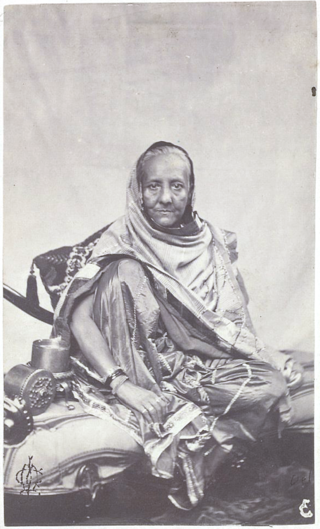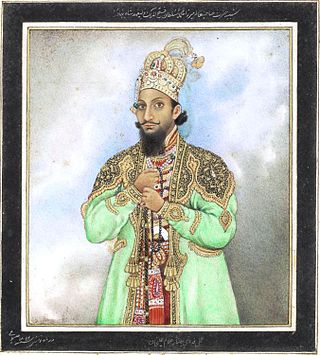
Bahadur Shah II (born Mirza Abu Zafar Siraj-ud-din Muhammad, usually referred to by his poetic title Bahadur Shah Zafar, was the twentieth and last Mughal emperor and an Urdu poet. He was the second son and the successor to his father, Akbar II, who died in 1837. He was a titular Emperor, as the Mughal Empire existed in name only and his authority was limited only to the walled city of Old Delhi. Following his involvement in the Indian Rebellion of 1857, the British deposed him and exiled him to Rangoon in British-controlled Burma in late 1858, after convicting him on several charges. The title of Empress of India was subsequently assumed by Queen Victoria.

Mirza Abu'l Fayaz Qutb-ud-Din Mohammad Azam, commonly known as Azam Shah, was briefly the seventh Mughal emperor from 14 March to 20 June 1707. He was the third son of the sixth Mughal emperor Aurangzeb and his chief consort Dilras Banu Begum.

General Bakht Khan (1797–1859) was the commander-in-chief of the Indian rebel forces in the city of Delhi during the Indian Rebellion of 1857 against the East India Company.

Mirza Mughal, born Muhammad Zahir ud-din Mirza, was a Mughal prince. He played a significant role during the Indian Rebellion of 1857. He was one of the Mughal princes shot dead at one of the gates of Old Delhi, which gate thereafter came to be known as "Khooni Darwaza".

Mirza Muhammad Khair ud-din, Khurshid Jah Bahadur or, Mirza Khurshid Jah Bahadur was born in Rang Mahal, Delhi the only son of Mirza Muhammad Fayazuddin Bahadur, by lineage he was the Great-Grandson of Shah Alam II, he was recognised as head of the Timurid dynasty, in 1931 by the Government of India, He emigrated to Lahore in Pakistan following the partition of India in 1947,

Sayyid Waris Ali Mirza Khan Bahadur was the last Nawab of Murshidabad before a prolonged interregnum caused by a succession dispute within the family that was only resolved in 2014 by the Indian Supreme Court. He succeeded his father, Wasif Ali Mirza.

Mirza Mahmud Shah Bahadur, also known by his regnal name Shah Jahan IV, was the eighteenth Mughal emperor for a brief period in 1788 after Shah Alam II was deposed by Ghulam Kadir, Mahmud Shah Bahadur was the son of a former Mughal Emperor, Ahmad Shah Bahadur. He himself became emperor for a brief period in 1788 as a puppet of Ghulam Kadir, after Shah Alam II had been deposed and blinded. He was allegedly put to death in 1790 by order of Shah Alam II, supposedly for usurping his authority in 1788.

Zeenat Mahal was the only wife and de facto regent of the Mughal Kingdom on behalf of her husband, the Mughal emperor Bahadur Shah Zafar.

Shahzada Mirza Fath-ul-Mulk Bahadur also known as Mirza Fakhru was the last Crown Prince of the Mughal Kingdom.

Shahzada Mirza Shah Abbas Bahadur was a prince of the Mughal Kingdom, the son of Emperor Bahadur Shah II, the last Emperor of India, by his wife Mubarak-un-Nissa Khanum Begum.

Abu'l-Hasan entitled by the Mughal emperor Jahangir as Asaf Khan, was the Grand Vizier of the fifth Mughal emperor Shah Jahan. He previously served as the vakil of Jahangir. Asaf Khan is perhaps best known for being the father of Arjumand Banu Begum, the chief consort of Shah Jahan and the older brother of Empress Nur Jahan,And The Maternal Grandfather Of Mughal Emperor Aurangzeb

Shahzada Mirza Jawan Bakht Bahadur was a Mughal prince and the eldest son of Emperor Shah Alam II and the grandson of Emperor Alamgir II. He was born in 1749 at the Red Fort, Delhi. Jawan Bakht was a very influential Timurid Prince of the Mughal Empire and he also briefly served as the Heir-apparent of the Mughal Empire. He traced his family line back over five hundred years to Chagatai Khan, the second son of Genghis Khan.
Mirza Jahangir was the son of Prince Mirza Jahan Shah, who became the Emperor Akbar Shah II in 1806 and his wife Empress Mumtaz Mahal, he was also the younger brother of Emperor Bahadur Shah II and older brother of Mirza Jahan Shah. Under the pressure of his mother, Mumtaz Begum, Akbar Shah declared him as his successor. However, after he attacked the British resident, Archibald Seton, in the Red Fort, the East India Company exiled him and eventually Bahadur Shah II succeed his father in 1837, to become the last Mughal ruler of India . He was subahdar of Assam from 1813 to 1818. He was the 32nd Mughal ruler in Assam.
Sahiba Mahal was the second wife of Mughal emperor Muhammad Shah.
Badshah Begum was from 8 December 1721 to 6 April 1748 as the first wife and chief consort of the Mughal emperor Muhammad Shah. She is popularly known by her title Malika-uz-Zamani which was conferred upon her by her husband, immediately after their marriage.
Events in the year 1707 in India.

Mirza Jawan Bakht was the son of Emperor Bahadur Shah Zafar and Zeenat Mahal. He was the fifteenth son of his father, but the only son of his mother. She nursed the ambition of placing him on the Mughal throne.
Mirza Khair-ud-din Muhammad Khizr Sultan Bahadur was a son of the last Mughal emperor, Bahadur Shah II.
The Mughal war of succession (1707–1709) or the Mughal Civil War was a period of political disorder and armed conflict over succession in the Mughal Empire following the death of the sixth Mughal emperor Aurangzeb in March 1707.
Jamshed Bakht was a Mughal descendant through his father, Mirza Jawan Bakht, son of Bahadur Shah II the last Mughal emperor. His mother was his father's maternal cousin Nawab Shah S Begum. In 1859, British authorities removed all bans and restrictions on the Mughal royalty and Bakht received a princely pension of 450 Rupees per month. He had married twice, secondly to Sultana Nadir Begum which allegedly produced Bakht's only son Bedaar Bakht, though he is said to have had at least one son out of wedlock through mistresses. He died in 1921 after which the princely pension was suspended till after Indian Independence.











